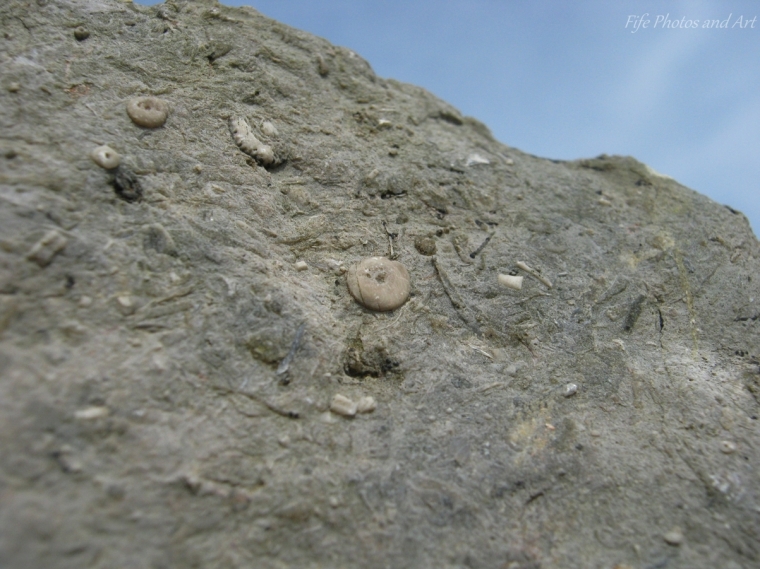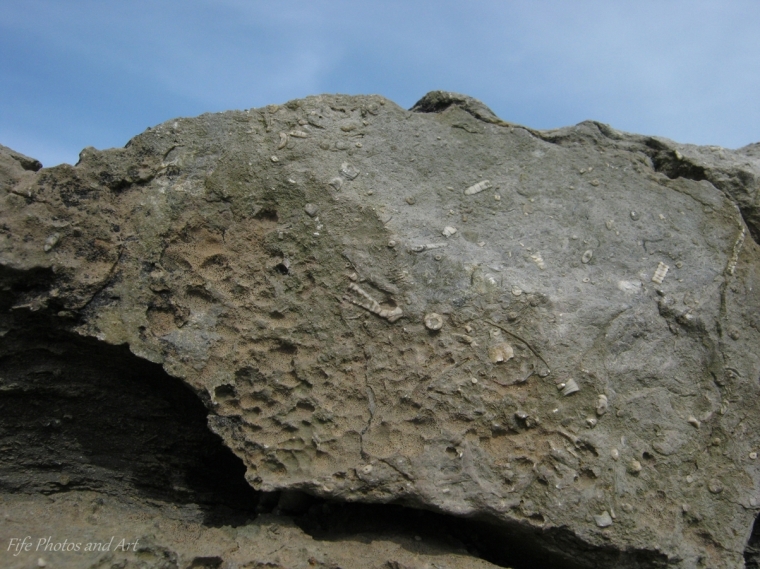This limestone is found at the base of the Lower Limestone Formation, which was deposited in the Carboniferous (approx 300 to 360 million years ago). Most of the Lower Limestone Formation consists of sandstones, siltstones and mudstones, very similar to the underlying Pathhead Formation, which were deposited in a swamp/deltaic environment (not dissimilar to the modern day Mississippi delta).
But sandwiched in between them, is the Hurlet Limestone which represents a major marine transgression, where the sea encroached over the flat lying delta regions, thus temporarily cutting off sediment supply, and allowing the growth of coral and crinoid banks, in the resulting shallow and warm sea. Over time, the sediments from the delta gradually pushed outwards again, covering up the limestones with yet more deltaic sandstones, siltstones and mudstones.



Wow, that’s utterly amazing. The time frame blows my mind, but my eyes seem to be fine with appreciating just how beautiful this is.
LikeLiked by 1 person
Geological time is certainly quite mind blowing Jac 🙂 Where I used to work, as a geological technician, anything that was less than 50 million years old was classed as recent, and not really worth looking at!! LOL! 🙂
LikeLiked by 1 person
Can you collect one shell ? 🙂
LikeLiked by 1 person
It’s quite difficult out in the field to collect just one shell, you really need specialist tools to do that Martina 🙂 And even then, it’s not an easy task, as the limestone is fairly hard, and consists of an almost identical mineral as the shell or in this case, crinoid stem fragments. In my previous job, I worked in some labs where we extracted micro fossils from all sorts of rock types, sometimes by dissolving the rock first in various acids (that was to collect the organic matter from the rock, and bugs like pollen, spores and dinoflagellates), aand sometimes using different disaggregation processes, to realease the microfossils. Most the fossils needed to be observed down a microscope 🙂
LikeLiked by 1 person
Very impressive! 🙂 You have an amazing career, Andy! 🙂
LikeLiked by 1 person
I was lucky at that time to be able to do a job that I enjoyed so much 🙂
LikeLiked by 1 person
Happy for you 🙂
LikeLiked by 1 person
Oh brilliant, I love finding things in rock. It’s hard to comprehend the age but good to feel in touch with the earth.
LikeLiked by 1 person
I too love my geology Gilly, you certainly feel much closer to Mother Nature when you get into your rocks – my fascination is knowing how each rock type or bed ended up being formed, each rock can tell you a fascinating history of that particular locality. I used to work as a geological technician, as I explained in my comment to Martina (SmartToughMom), either above or below your comment Gilly 🙂
LikeLike
Terrific post! I’m sitting here smiling at the idea of the words warm, corals and Kinghorn belonging in the same sentence. Geological time is utterly fascinating — though a little scary when it decides to speed up a bit as is happening to us at the moment.
LikeLiked by 1 person
Lol!!! I hadn’t thought of the incongruous nature of what I had described Su!!!! But of course, at that time Kinghorn pretty much lay on the equator 🙂
You’re right about the apparent speeding up of geological time Su, sea levels have changed hundreds or thousands of times before – in fact, there is a whole new branch to geology that I’m particularly interested in, called sequence stratigraphy, that is based almost entirely on these sea level changes. But in the past, these changes took place over a period of thousands of years (which in itself is just a mere blink of the eye geologically speaking), but we as a human race are compressing it into mere decades!!!! 😦
LikeLiked by 1 person
Nature has done some pretty nifty sea-level change here in the last fortnight. The big earthquake (as opposed to the biggish aftershocks) raised the sea-bed on the Kaikoura coast by several metres. It’s made the harbour unusable and damaged/destroyed shellfish beds which were an important part of the local economy! BTW: what do you know about “slow slip events”? We’re apparently experiencing a few of them to go with our “fast shake events”
LikeLiked by 1 person
That is some amazing instant geological processes (other than earthquakes, volcanic eruptions and meteorite impacts, most geological processes take years or thousands of years to show a marked difference!). It shows how we mustn’t take things for granted in plate margin areas – not that that is any help for the people in that local community that have lost their livelihood! But it must be an amazing thing to see, from a geological standpoint 🙂
Thanks for making me aware of slow slip events, I’m not really into this aspect of geology (I’m more of a sedimentology/stratigraphy type of guy! LOL!), but it was fascinating reading up about it 🙂
They occur at depths generally a wee bit deeper than where your normal earthquakes occur. At shallower depths, as the the Pacific plate sinks below the New Zealand plate (subduction), it tends to stick due to friction, and then suddenly move a few centimetres in a jolt, thus creating an earthquake.
These slow slip events occur where there is less friction, and rather than a sudden jolt, the plates pass relatively smoothly over one another, over a period of days, weeks or even months. Geologists have detected this movement from surface GPS measurements. But although these silent earthquakes appear to be beneficial, from the sounds of it, they generate stress in other areas of the subduction zone, that can then generate more actual earthquakes! It’s all very fascinating 🙂
LikeLiked by 1 person
Thanks for that Andy. Geology is really fascinating, and it must be incredibly cool for researchers to have so much new data at the moment — though the human and economic cost is pretty high at the moment. But on the other hand, all that data does help us plan better for the future of these shaky isles!
LikeLiked by 1 person
You’re welcome Su, it was fun to look it up 🙂
I certainly hope that with all the technology that is available now, they can help to predict when earthquakes may occur 🙂
LikeLiked by 1 person
GeoNet here is doing a really good job communicating the data they collect. They are developing scenarios and calculating the likelihood of each. It is fascinating!
LikeLiked by 1 person
That sounds brilliant Su 🙂 It’s good that they are publishing all their data, too many organisations tend to keep information to themselves, in case a competitor can gain something from their findings! All info on earthquakes and volcanology should be freely available to everyone 🙂
LikeLike
I must look more closely next time I’m on the beach and near the rocks Andy. It is a fascinating area of study. Great post and photos.
LikeLiked by 1 person
Thanks Diana 🙂 It’s the part of the coast on the way back towards Kirkcaldy, there is about 5 limestone beds between Kinghorn and Seafield, two of which are actually the same beds that outcrop twice 🙂 Just to the NE of Kinghorn, just below the coast path, there are some really nice pillow lavas too – they formed when volcanic rock extruded into the surrounding sea, not the North sea, but I think it was called the Rheic Ocean 🙂
LikeLiked by 1 person
Good Lord, you sound just like my husband. 😆
LikeLiked by 1 person
It sounds like your hubby, Kerry, must be a very interesting guy!!! 🙂
LikeLiked by 2 people
Yeah, he has been trying to persuade me of that for 34 years… 😆 When he came out of anesthetic in the US, he was babbling on about sediments and rocks to the bafflement of the staff. I reassured them that this meant he was perfectly ok!
LikeLiked by 1 person
Lol!!!! Even though I’ve never met him Kerry, it sounds that your husband is very similar to me! 🙂
LikeLiked by 1 person
He is, indeed, and his name is Andy.
LikeLiked by 1 person
Lol!!! Us Andy’s must just be naturally interesting!! LOL!! My wife would say we are just naturally boring! 😦
LikeLiked by 1 person
We have much in common… 😆
LikeLiked by 1 person
🙂
LikeLiked by 1 person
Astounding! Quite near you? 🙂
LikeLiked by 1 person
About 5 miles away Jo 🙂 The Fife coastline consists almost totally of Carboniferous sediments and volcanics, and there are a reasonable number of limestones included within the deltaic sandstones that make up much of the strata. Fife also has some quite extensive Coal Measures strata, but most of that is sub surface. As an amateur sedimentologist, I’m as happy as a …………………. ie I love living up here! 🙂
LikeLiked by 1 person
Its incredible really, seeing all these fossils etc from days ago!
LikeLiked by 1 person
Geology is a fascinating subject Lily 🙂 It seems almost right that these rocks are located on the beach in Fife, but there are identical strata to these approx 5 miles away, that are 700ft above sea level!!! It’s just sheer coincidence that these marine fossils are located in this particular case by the beach 🙂
LikeLiked by 1 person
It is pretty amazing to think about the age of these rocks and the signs of life over 300 million years ago!
LikeLiked by 1 person
Sorry for taking such a long time to get back to you Inger (almost as long a time, as the age of this limestone!!! Lol!), it is amazing when you see any fossils that are millions of years old 🙂
LikeLiked by 1 person